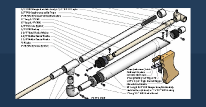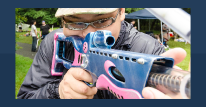What you'll need:
-flexible, load bearing cord (I just went into the cord/wire/chain section of Ace and got the thinnest wire, which I believe was wound steel and had a max load of 97 pounds, more than enough for a plusbow spring)
-2 ferrules that fit the wire
-a SNAP
-some sort of priming handle, I used a 1/2" CPVC tee
-it helps to use a hollow pistol grip from an airsoft/paintball gun, it helps for nesting the key retention thingy.
-one of those key winders, I used a really overpriced ace brand one because that's all they had, it was like 12 bucks... at least its really strong.
There are a couple problems/precautions-to-be-taken that Split has noted about the priming system. One is the small plunger rod turning. This affects a +bow/pistol set-up, but doesn't matter at all for a SNAP. The second is that the spring needs to be locked into place where it touches the spring rest and the plunger. I'm not quite sure how Split did this with the +pistol, but the majority of this write-up covers that with a SNAP.
First let's get an over-view of the internals. I'll explain the individual parts later.

Now let's work on the spring rest. Inside of the hex plug I nested and glued it a DTB plunger tube, which fits around the [k26] spring very nicely and not too tightly. I know for a fact that a firefly plunger tube will work for this as well. The end I held up to a flame and bent outwards. This reduces the risk of the spring catching on the edges while it's getting compressed.


Now to the other end - the plunger. The plunger head is pretty much standard and has several inches of CPVC sticking out the back, which the [k26] fits nicely over. The wire goes through the CPVC and is looped at the end with the ferrule. The loop goes around a screw that is visible in one of the pictures. Make sure to grind the screw head and end down so they are flush with the plunger - you don't want it catching on the catch or scratching up the plunger tube.


The priming handle is pretty easy. Just create another loop with the other ferrule like before and loop it around a screw running through the CPVC handle.
Installing the key winder should be pretty straightforward. Just run it through the handle if it's hollow. If not, figure something else out. The last step is bolting on a piece of CPVC to help guide the chain. I just filled it with hot glue and then drilled through.

Here's what it looks like primed.

And here she is in all her glory.

What do ya guys think?


















